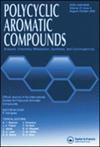基于密度泛函理论和分子对接模拟的2-(4-甲氧基苯基)-4,6-双(三氯甲基)-1,3,5-三嗪作为SARS-CoV-2有效抑制剂的光谱量子计算
IF 2.6
3区 化学
Q2 CHEMISTRY, ORGANIC
引用次数: 0
摘要
本研究利用密度泛函理论(DFT)在B3LYP/ 6-311 ++G(d,p)/cc-pVDZ基集上识别2-(4-甲氧基苯基)-4,6-二(三氯甲基)-1,3,5三嗪(MSTCMT)的实验和计算光谱行为具有重要意义。在VEDA的辅助下,利用FT-IR和拉曼分别在3500-400 cm−1和3500-600 cm−1范围内进行了详细的振动分析。核磁共振(NMR)获得的化学位移为分析MSTCMT的分子结构提供了重要的信息。在298.15 K下,用B3LYP方法计算了MSTCMT分子在6-311 ++G(d,p)和cc-pVDZ基组下的热力学函数。利用B3LYP水平的6-311 ++G(d,p)和cc-pVDZ基集计算了MSTCMT分子的非线性光学性质,如极化率、一阶超极化率和二阶超极化率。通过分子对接检测MSTCMT对SARS-CoV-2受体的抑制作用。本文章由计算机程序翻译,如有差异,请以英文原文为准。
Spectroscopic Quantum Calculations Using Density Functional Theory and Molecular Docking Simulations on 2-(4-Methoxystyryl)-4,6-Bis(Trichloromethyl)-1,3,5-Triazine as Potent Inhibitor against SARS-CoV-2
The present investigation is insightful in discerning the experimental and computational spectroscopic behavior of 2-(4-methoxystyryl)-4,6-bis(trichloromethyl)-1,3,5 triazine (MSTCMT) by employing density functional theory (DFT) at B3LYP/6–311++G(d,p)/cc-pVDZ basis sets. The detailed vibrational analysis has been carried out using FT-IR and Raman within 3500–400 cm−1 and 3500–600 cm−1 respectively assisted by VEDA. Chemical shifts obtained from nuclear magnetic resonance (NMR) provided essential information useful in analyzing the molecular structure of MSTCMT. The thermodynamic functions of the MSTCMT molecule have been calculated at 298.15 K using the B3LYP method at 6–311++G(d,p) and cc-pVDZ basis sets. The non-linear optical properties such as polarizability, first-order hyperpolarizability, and second-order hyperpolarizability of the MSTCMT molecule have been calculated using 6–311++G(d,p) and cc-pVDZ basis set at B3LYP level. Molecular docking has been performed to check the inhibitory effect of MSTCMT against the SARS-CoV-2 receptors.
求助全文
通过发布文献求助,成功后即可免费获取论文全文。
去求助
来源期刊

Polycyclic Aromatic Compounds
化学-有机化学
CiteScore
3.70
自引率
20.80%
发文量
412
审稿时长
3 months
期刊介绍:
The purpose of Polycyclic Aromatic Compounds is to provide an international and interdisciplinary forum for all aspects of research related to polycyclic aromatic compounds (PAC). Topics range from fundamental research in chemistry (including synthetic and theoretical chemistry) and physics (including astrophysics), as well as thermodynamics, spectroscopy, analytical methods, and biology to applied studies in environmental science, biochemistry, toxicology, and industry. Polycyclic Aromatic Compounds has an outstanding Editorial Board and offers a rapid and efficient peer review process, as well as a flexible open access policy.
 求助内容:
求助内容: 应助结果提醒方式:
应助结果提醒方式:


